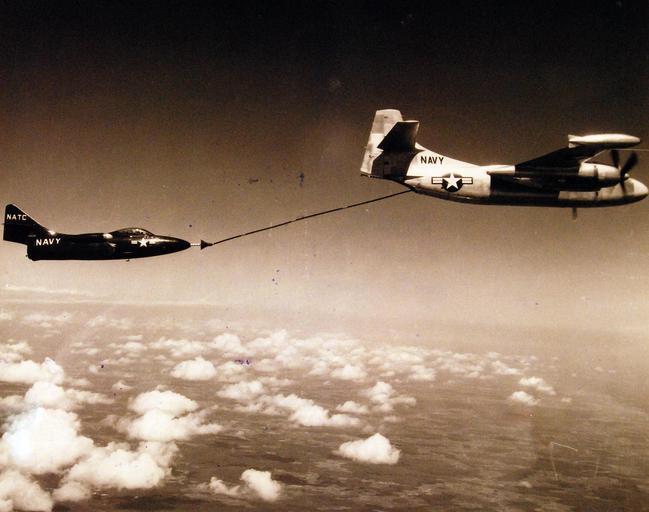MAKE A MEME
View Large Image

| View Original: | 330-PS-2938_(USN_708695).jpg (2876x2268) | |||
| Download: | Original | Medium | Small | Thumb |
| Courtesy of: | www.flickr.com | More Like This | ||
| Keywords: outdoor 330-PS-2938 (USN 708695): US Navy Develops Refueling System for Carrier Planes in Flight. Successful development of an in-flight refueling system for carrier aircraft. Modeled after the British “Drogue and Probe” Method, the U.S. Navy’s in-flight refueling technique is accomplished when the pilot flies his aircraft, equipped with a refueling lance, into the probe device fastened at the end of the hose on a tanker aircraft. Various U.S. Navy carrier fighters are being equipped with refueling equipment. Tactical advantages to be gained by mid-air refueling are longer range offensive missions, combat air patrols for longer periods, and increased armament loads by fighter aircraft, carrying only minimum fuel at takeoff, and refueling in the air, en-route to targets. This AJ “Savage” modified for use as a “tanker” refuels a Grumman F9F “Panther” in evaluation tests at Naval Air Test Center, Patuxent River, Maryland, August 25, 1952. (5/12/2015). 330-PS-2938 (USN 708695): US Navy Develops Refueling System for Carrier Planes in Flight. Successful development of an in-flight refueling system for carrier aircraft. Modeled after the British “Drogue and Probe” Method, the U.S. Navy’s in-flight refueling technique is accomplished when the pilot flies his aircraft, equipped with a refueling lance, into the probe device fastened at the end of the hose on a tanker aircraft. Various U.S. Navy carrier fighters are being equipped with refueling equipment. Tactical advantages to be gained by mid-air refueling are longer range offensive missions, combat air patrols for longer periods, and increased armament loads by fighter aircraft, carrying only minimum fuel at takeoff, and refueling in the air, en-route to targets. This AJ “Savage” modified for use as a “tanker” refuels a Grumman F9F “Panther” in evaluation tests at Naval Air Test Center, Patuxent River, Maryland, August 25, 1952. (5/12/2015). | ||||